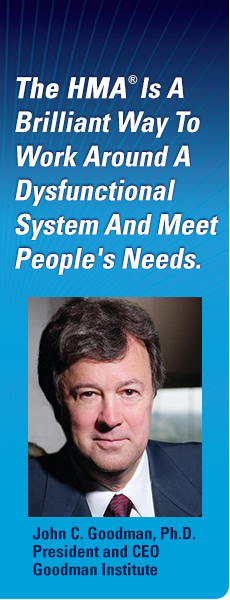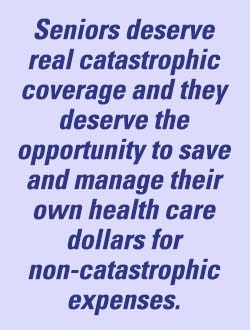
How Government Abuses The
Elderly And Why All Seniors
Need To Consider The
Health Matching Account
The federal government spends an enormous amount of money on the elderly – far more, for example, than it spends on children.
The federal government spends an
enormous amount of money on the elderly – far more, for example, than it spends on children.
At the same time, rules, regulations, taxes and penalties create enormous burdens for senior citizens when they do such ordinary things as work for wages, withdraw funds from an IRA or even try to insure for medical expenses.
Seniors who claim early retirement under Social Security face the highest tax rates in the nation when they earn more than a modest amount of wage income. These tax rates can exceed 90 percent, and they are far higher than the rates faced by Warren Buffett or Jeff Bezos. Some seniors face higher tax rates on capital gains and pension fund income than younger people at the same income level. Some are even taxed on their tax-exempt income!
Although accountants tend to be well aware of the pitfalls seniors face under the income tax law, even CPAs tend to be unaware of the problems seniors encounter when they try to insure against unexpected medical expenses.
Take Health Savings Accounts (HSAs). This is an extremely popular way nonseniors self-insure for
medical expenses not paid for by third-party health insurance. People can put pre-tax dollars in their HSA, and employers can contribute as
well. Funds can be invested at the owner’s discretion and the accounts are completely portable – traveling with an employee from job to job and in and out of the labor market.
Currently, about 30 million Americans have an HSA with an accumulated $82 billion on hand.
Here’s the problem. Seniors can’t have one. Once you become eligible for Medicare you can no longer open and contribute to an HSA. And that’s too bad — because seniors on Medicare have a lot of out-of-pocket medical costs.
Take prescription drugs. A senior who enrolls in Medicare Part A (hospital services), Medicare Part B (doctor services) and Medicare Part D (drugs) can face considerable out-of-pocket medical costs for drugs, even after paying premiums. Medigap insurance (which is supposed to fill the gaps in Medicare coverage) doesn’t help. For some strange reason, the law doesn’t
allow Medigap to pay for the patient’s share of drug costs.
If you are wondering what that might mean, consider that a study of 28 expensive specialty drugs found that among Medicare enrollees covered by Part D drug insurance, the out-of-pocket spending by patients ranged from $2,622 to $16,551. And those are annual costs!
Here is how Medicare drug coverage is worked in 2021. After a deductible of $445, Medicare pays 75 cents of the next dollar of cost. And it pays 75 cents of the dollar after that. It keeps on doing this until the patient’s out-of-pocket expenses reach a limit of $6,550. Above that amount, in the “catastrophic phase,” the patient
is responsible for 5 percent of any additional costs. For the 28 drugs mentioned above, more than half (61 percent) would require an average cost of $5,444 in out-of-pocket costs in the catastrophic phase alone.
Other than changing federal law, is there a market based alternative? As I explained in a previous post at Forbes, a Houston based firm called Health Matching Account Services (HMAS®), through their patented and trademarked medical savings account plan called the Health Matching Account (HMA®) has been offering young people and seniors alike a way of covering out-of-pocket medical costs that is intriguing for many years now. In recent years, the HMA® has become well established in the senior market.
It works like this. The HMA® will match what is
contributed each month with additional medical
benefits that will approach three and sometimes
four times what is paid in on a monthly basis.
There are 11 different HMA® plan levels with varying monthly contributions ranging from $40 per month all the way up to $725 per month that can fit into any senior’s budget. For example, with the HMA® 10000 plan option, seniors make a monthly contribution of $140 towards their account balance. After 12 months, they will have paid $1,680. For that amount, they will have coverage for the first $1,980 of their out-of-pocket medical expenses that are not covered by Medicare. In other words, the HMA® plan owners are getting $1.17 of medical coverage for every $1.00 they paid into the plan on average for the first year.
Things get better in year two (where you get more than $2 of coverage for every $1 of contribution) and better still in year three (where you get almost $3 of coverage for every $1 of contribution). After 35 months of contributions towards their HMA® plan, people with no medical bills will have $10,000 in medical benefits at their disposal to use in return for only $4,900 that they have paid into the plan.
The HMA® account balance is also very resilient and can build back up even faster after a medical expense occurs, which can lead to additional, significant, medical savings. Say you have a drug expense that costs $4,600 and you pay for it from the HMA®. That would reduce
your coverage level in your HMA® account balance down to $5,400 from $10,000. You can replenish the account by continuing to make your $140 monthly payment over 11 months, which for only $1,540 will buy back that $4,600 of lost medical coverage due to your large prescription drug expense and increase your first-dollar medical coverage back up to $10,00 at a rate of about 3 to 1.
This account, by the way, can be used to pay out-of-pocket deductibles, copayments or coinsurance under all parts of Medicare. It can
also be used to pay for medical expenses Medicare doesn’t cover, including hearing, vision and dental.
This is a brilliant way to work around a dysfunctional system and meet people’s needs.
But as I wrote the last time I discussed this idea, what we need even more is deregulation.
Seniors deserve real catastrophic coverage and they deserve the opportunity to save and manage their own health care dollars for non-catastrophic expenses. The market is
capable of meeting all these needs if we just let it work, and the HMA® proves that.



email: info@goodmaninstitute.org • +1 214 302.0406
The Goodman Institute for Public Policy is a 501(c)(3) nonprofit organization and contributions are tax-deductible to the fullest extent of the law.
A tax receipt will be issued directly from the Goodman Institute within 2 business days after the receipt of your donation.
This article is based on the version that appeared in forbes.com on January 28, 2022.![]()
The HMA® is not health insurance.
The HMA® Medical Reimbursement Visa® Prepaid Card is issued pursuant to a license from the Visa® U.S.A Inc.
Card may not be used everywhere Visa® debit cards are accepted.
See HMA® Member Contract for list of eligible goods, services and merchants.

